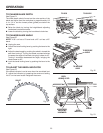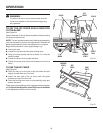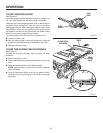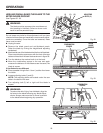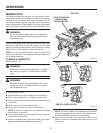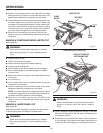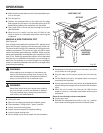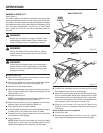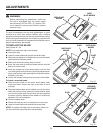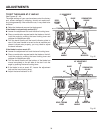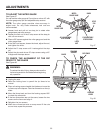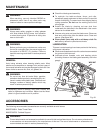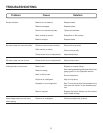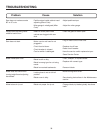
31
OPERATION
LARGE PANEL CUT
SUPPORTS
HEIGHT/BEVEL
ADJUSTING
HANDWHEEL
RIP FENCE
Fig. 39
Make sure the wood does not touch the blade before you
turn on the saw.
Turn the saw on.
Position the workpiece flat on the table with the edge
flush against the rip fence. Let the blade build up to full
speed before feeding the workpiece into the blade.
Use a push stick to move the piece through the cut and
past the blade.
When the cut is made, turn the saw off. Wait for the
blade to come to a complete stop before removing the
workpiece.
MAKING A NON-THROUGH CUT
See Figure 40.
Non-through cuts (made with a standard 10 in. blade) can be
made with the grain (ripping) or across the grain (cross cut).
The use of a non-through cut is essential to cutting grooves,
rabbets, and dadoes. This is the only type cut that is made
without the blade guard assembly installed. Make sure the
blade guard assembly is reinstalled upon completion of this
type of cut. Read the appropriate section which describes
the type of cut in addition to this section on non-through or
dado cuts. For example, if your non-through cut is a straight
cross cut, read and understand the section on straight cross
cuts before proceeding.
WARNING:
When making a non-through cut, the cutter is cov-
ered by the workpiece during most of the cut. Be
alert to the exposed cutter at the start and finish of
every cut to avoid the risk of personal injury.
WARNING:
Never feed wood with your hands when making
any non-through cut such as rabbets or dadoes.
To avoid personal injury, always use push blocks,
push sticks, and featherboards.
Unplug the saw.
Remove the blade guard and anti-kickback pawls.
Place spreader / riving knife in “down” position.
Unlock the bevel locking lever.
Adjust the bevel angle to the desired setting.
Lock the bevel locking lever.
Set the blade to the correct depth for the workpiece.
Depending on the shape and size of the wood, use either
the rip fence or miter gauge.
Plug the saw into the power source and turn the saw
on.
Let the blade build up to full speed before moving the
workpiece into the blade.
Always use push blocks, push sticks, and featherboards
when making non-through cuts to avoid the risk of serious
injury.
When the cut is made, turn the saw off. Wait for the
blade to come to a complete stop before removing the
workpiece.
Once all non-through cuts are completed:
Unplug your saw.
Reinstall the spreader/riving knife in the “up” position
then install the blade guard and anti-kickback pawls.



